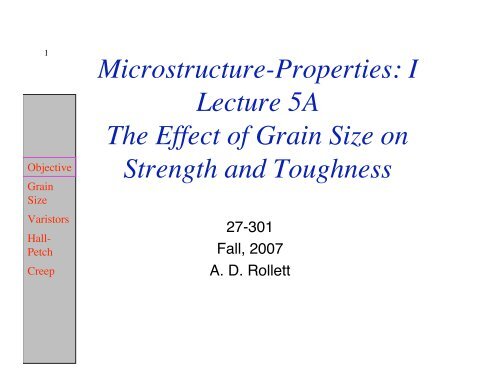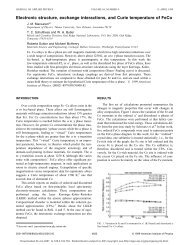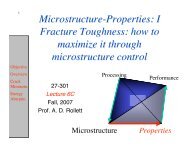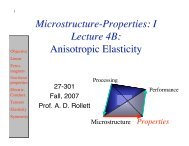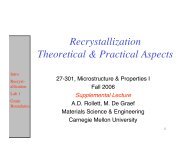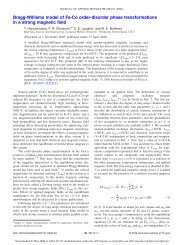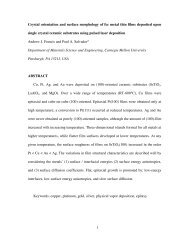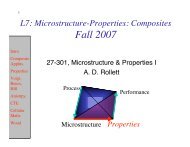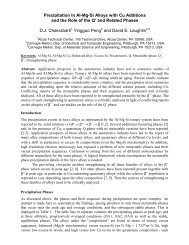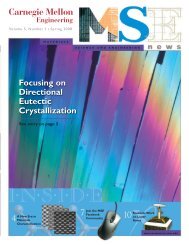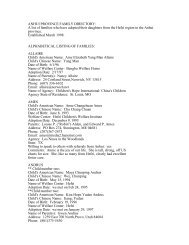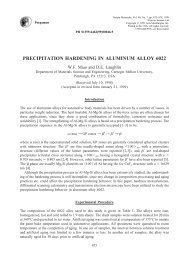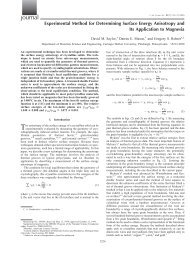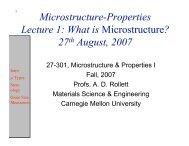Microstructure-Properties: I Lecture 5A The Effect of Grain Size on ...
Microstructure-Properties: I Lecture 5A The Effect of Grain Size on ...
Microstructure-Properties: I Lecture 5A The Effect of Grain Size on ...
Create successful ePaper yourself
Turn your PDF publications into a flip-book with our unique Google optimized e-Paper software.
1<br />
Objective<br />
<str<strong>on</strong>g>Grain</str<strong>on</strong>g><br />
<str<strong>on</strong>g>Size</str<strong>on</strong>g><br />
Varistors<br />
Hall-<br />
Petch<br />
Creep<br />
<str<strong>on</strong>g>Microstructure</str<strong>on</strong>g>-<str<strong>on</strong>g>Properties</str<strong>on</strong>g>: I<br />
<str<strong>on</strong>g>Lecture</str<strong>on</strong>g> <str<strong>on</strong>g>5A</str<strong>on</strong>g><br />
<str<strong>on</strong>g>The</str<strong>on</strong>g> <str<strong>on</strong>g>Effect</str<strong>on</strong>g> <str<strong>on</strong>g>of</str<strong>on</strong>g> <str<strong>on</strong>g>Grain</str<strong>on</strong>g> <str<strong>on</strong>g>Size</str<strong>on</strong>g> <strong>on</strong><br />
Strength and Toughness<br />
27-301<br />
Fall, 2007<br />
A. D. Rollett
2<br />
Objective<br />
<str<strong>on</strong>g>Grain</str<strong>on</strong>g><br />
<str<strong>on</strong>g>Size</str<strong>on</strong>g><br />
Varistors<br />
Hall-<br />
Petch<br />
Creep<br />
Bibliography<br />
• Mechanical Behavior <str<strong>on</strong>g>of</str<strong>on</strong>g> Materials (1966), F. McClintock and<br />
A. S. Arg<strong>on</strong>, Addis<strong>on</strong> Wesley.<br />
• Mechanical Behavior <str<strong>on</strong>g>of</str<strong>on</strong>g> Materials, T.H. Courtney, McGraw-<br />
Hill, ISBN 0-07-013265-8, 620.11292,C86M<br />
• <str<strong>on</strong>g>Microstructure</str<strong>on</strong>g> and <str<strong>on</strong>g>Properties</str<strong>on</strong>g> <str<strong>on</strong>g>of</str<strong>on</strong>g> Materials, J.C.M. Li, editor,<br />
World Scientific, ISBN 981-02-2403-6<br />
• Leslie, WC, <str<strong>on</strong>g>The</str<strong>on</strong>g> Physical Metallurgy <str<strong>on</strong>g>of</str<strong>on</strong>g> Steels, Hemisphere<br />
Press, McGraw-Hill<br />
• Llewellyn, DT & Hudd, RC, Steels, Metallurgy and<br />
Applicati<strong>on</strong>s, Butterworths-Heinemann<br />
• http://www.steeluniversity.org/c<strong>on</strong>tent/html
3<br />
Objective<br />
<str<strong>on</strong>g>Grain</str<strong>on</strong>g><br />
<str<strong>on</strong>g>Size</str<strong>on</strong>g><br />
Varistors<br />
Hall-<br />
Petch<br />
Creep<br />
Objective<br />
• This lecture is c<strong>on</strong>cerned with the effects <str<strong>on</strong>g>of</str<strong>on</strong>g> grain<br />
size <strong>on</strong> properties.<br />
• Two examples will be given:<br />
• (4A) <str<strong>on</strong>g>The</str<strong>on</strong>g> effect <str<strong>on</strong>g>of</str<strong>on</strong>g> grain size <strong>on</strong> mechanical<br />
properties (Hall-Petch effect, Nabarro-Herring<br />
creep).<br />
• (4B) <str<strong>on</strong>g>The</str<strong>on</strong>g> effect <str<strong>on</strong>g>of</str<strong>on</strong>g> grain size <strong>on</strong> resistance in<br />
ceramics used for varistors (e.g. in surge<br />
protectors).<br />
• If time permits, the discussi<strong>on</strong> will be extended to<br />
magnetic hardness also.
4<br />
Objective<br />
<str<strong>on</strong>g>Grain</str<strong>on</strong>g><br />
<str<strong>on</strong>g>Size</str<strong>on</strong>g><br />
Varistors<br />
Hall-<br />
Petch<br />
Creep<br />
Key C<strong>on</strong>cepts<br />
• <str<strong>on</strong>g>Grain</str<strong>on</strong>g> boundaries (effectively) have properties that differ from<br />
the matrix.<br />
• <str<strong>on</strong>g>Properties</str<strong>on</strong>g> <str<strong>on</strong>g>of</str<strong>on</strong>g> polycrystal depend <strong>on</strong> the c<strong>on</strong>tent <str<strong>on</strong>g>of</str<strong>on</strong>g> planar<br />
defects, i.e. grain boundaries, i.e. grain size.<br />
• <str<strong>on</strong>g>Grain</str<strong>on</strong>g> boundaries in semic<strong>on</strong>ductors used to make varistors<br />
have a <strong>on</strong>e-way voltage barrier.<br />
• <str<strong>on</strong>g>The</str<strong>on</strong>g> Hall-Petch effect quantifies the trend <str<strong>on</strong>g>of</str<strong>on</strong>g> increasing<br />
strength and toughness with decreasing grain size. That is to<br />
say, fine grain size strengthens the material.<br />
• Creep rates (Coble creep) increase with increasing grain<br />
boundary area (per unit volume), hence decreasing grain size.<br />
<str<strong>on</strong>g>The</str<strong>on</strong>g>refore grain size has the opposite effect at high<br />
temperatures where fine grain size weakens the material.<br />
• Low temperature service optimized by fine grain size, but high<br />
temperature service optimized by use <str<strong>on</strong>g>of</str<strong>on</strong>g> single crystals.
5<br />
Objective<br />
<str<strong>on</strong>g>Grain</str<strong>on</strong>g><br />
<str<strong>on</strong>g>Size</str<strong>on</strong>g><br />
Varistors<br />
Hall-<br />
Petch<br />
Creep<br />
• σ y : yield strength<br />
• σ 0 : fricti<strong>on</strong> stress<br />
• K : Hall-Petch coefficient<br />
• d : grain size<br />
Notati<strong>on</strong><br />
• n : number <str<strong>on</strong>g>of</str<strong>on</strong>g> dislocati<strong>on</strong>s in<br />
a pile-up<br />
• ν : Poiss<strong>on</strong>’s ratio<br />
• G : shear modulus<br />
• τ : shear stress<br />
• J : vacancy flux<br />
• D : diffusi<strong>on</strong> coefficient<br />
• T : temperature<br />
• T m : melt T<br />
• Ω : atomic volume<br />
• σ : stress<br />
• N : c<strong>on</strong>centrati<strong>on</strong> <str<strong>on</strong>g>of</str<strong>on</strong>g><br />
vacancies<br />
• Q m : Activati<strong>on</strong> energy for<br />
migrati<strong>on</strong><br />
• Q Vacancy : Activati<strong>on</strong> energy<br />
for vacancy formati<strong>on</strong><br />
• kT : Boltzmann’s c<strong>on</strong>stant<br />
multiplied by temperature
6<br />
Objective<br />
<str<strong>on</strong>g>Grain</str<strong>on</strong>g><br />
<str<strong>on</strong>g>Size</str<strong>on</strong>g><br />
Varistors<br />
Hall-<br />
Petch<br />
Creep<br />
Hall-Petch <str<strong>on</strong>g>Effect</str<strong>on</strong>g><br />
• <str<strong>on</strong>g>The</str<strong>on</strong>g> Hall-Petch effect is<br />
remarkably simple to<br />
express but still difficult to<br />
explain in fundamental<br />
terms.<br />
• At ambient c<strong>on</strong>diti<strong>on</strong>s (no<br />
creep), yield strength<br />
rises as the grain size<br />
decreases.<br />
• <str<strong>on</strong>g>The</str<strong>on</strong>g> variati<strong>on</strong> in strength<br />
can be described by a<br />
power-law relati<strong>on</strong>ship:<br />
σ y = σ 0 + kd -1/2<br />
http://www.steeluniversity.org/c<strong>on</strong>tent/htmłeng/default.asp?catid=171&page<br />
id=2081271789 - after:<br />
“<str<strong>on</strong>g>The</str<strong>on</strong>g> yield stress-grain size relati<strong>on</strong> in ir<strong>on</strong> substituti<strong>on</strong>al alloys (<str<strong>on</strong>g>Grain</str<strong>on</strong>g> size<br />
effects <strong>on</strong> ir<strong>on</strong> substituti<strong>on</strong>al alloys yield stress, investigating Hall-Petch<br />
relati<strong>on</strong>)”, MORRISON, W B; LESLIE, W C<br />
Metallurgical Transacti<strong>on</strong>s. Vol. 4, pp. 379-381. Jan. 1973<br />
<str<strong>on</strong>g>The</str<strong>on</strong>g> Hall-Petch effect is named for E.O. Hall and N.J. Petch<br />
from their papers <str<strong>on</strong>g>of</str<strong>on</strong>g> the early 1950’s, e.g. “<str<strong>on</strong>g>The</str<strong>on</strong>g> Cleavage<br />
Strength <str<strong>on</strong>g>of</str<strong>on</strong>g> Crystals” N.J. Petch, J. Ir<strong>on</strong> & Steel Inst., 174,<br />
25-28.
7<br />
Objective<br />
<str<strong>on</strong>g>Grain</str<strong>on</strong>g><br />
<str<strong>on</strong>g>Size</str<strong>on</strong>g><br />
Varistors<br />
Hall-<br />
Petch<br />
Creep<br />
Dislocati<strong>on</strong> Pile-ups<br />
• <str<strong>on</strong>g>The</str<strong>on</strong>g> central idea is that dislocati<strong>on</strong>s are forced to<br />
pile up at grain boundaries, either because there is<br />
a barrier to crossing over into the next grain, or<br />
because a source must be activated in the next<br />
grain.<br />
[Courtney]
8<br />
Objective<br />
<str<strong>on</strong>g>Grain</str<strong>on</strong>g><br />
<str<strong>on</strong>g>Size</str<strong>on</strong>g><br />
Varistors<br />
Hall-<br />
Petch<br />
Creep<br />
Dislocati<strong>on</strong> Pile-up at a Boundary<br />
• <str<strong>on</strong>g>The</str<strong>on</strong>g> classical explanati<strong>on</strong> for the<br />
Hall-Petch effect is that some<br />
stress c<strong>on</strong>centrati<strong>on</strong> in a given<br />
grain is required to initiate slip in<br />
its neighboring grain. That stress<br />
c<strong>on</strong>centrati<strong>on</strong> is most plausibly<br />
obtained through a dislocati<strong>on</strong><br />
pile-up, see figure 5.5. <str<strong>on</strong>g>The</str<strong>on</strong>g><br />
essence <str<strong>on</strong>g>of</str<strong>on</strong>g> the argument is that<br />
stress is higher as the number <str<strong>on</strong>g>of</str<strong>on</strong>g><br />
dislocati<strong>on</strong>s increases. Thus the<br />
larger the grain size, the more<br />
quickly (in terms <str<strong>on</strong>g>of</str<strong>on</strong>g> macroscopic<br />
strain) is the critical stress reached<br />
at which slip is initiated in the<br />
neighboring grain. <str<strong>on</strong>g>The</str<strong>on</strong>g> form <str<strong>on</strong>g>of</str<strong>on</strong>g> the<br />
equati<strong>on</strong> describing the pile-up<br />
stress c<strong>on</strong>tains a term in √(d/r)<br />
where d is the grain diameter and<br />
r is the (average) distance to the<br />
source in the neighboring grain<br />
from the boundary.<br />
!<br />
Number <str<strong>on</strong>g>of</str<strong>on</strong>g> (edge) dislocati<strong>on</strong>s in pile - up :<br />
n = (1"#)$%d<br />
4Gb<br />
Stress at the head <str<strong>on</strong>g>of</str<strong>on</strong>g> the pile - up :<br />
% c = n% = (1"#)$% 2 d<br />
4Gb<br />
Now invert the relati<strong>on</strong>ship to find<br />
the shear stress to overcome the critical<br />
breaking stress <str<strong>on</strong>g>of</str<strong>on</strong>g> the grain boundary<br />
and insert a fricti<strong>on</strong> stress (e.g. solutes):<br />
% applied = % i + 4Gb% c<br />
$d<br />
"1/ 2<br />
= % i + kd
9<br />
Objective<br />
<str<strong>on</strong>g>Grain</str<strong>on</strong>g><br />
<str<strong>on</strong>g>Size</str<strong>on</strong>g><br />
Varistors<br />
Hall-<br />
Petch<br />
Creep<br />
Stress c<strong>on</strong>centrati<strong>on</strong><br />
• <str<strong>on</strong>g>The</str<strong>on</strong>g> square root term is analogous to the stress c<strong>on</strong>centrati<strong>on</strong> at the<br />
tip <str<strong>on</strong>g>of</str<strong>on</strong>g> a penny-shaped crack (in fracture mechanics). Thus,<br />
(τ applied - τ i ) √(d/4r) = τ*,<br />
where τ* is the critical stress for dislocati<strong>on</strong> source activati<strong>on</strong>, τ i is<br />
the resistance to dislocati<strong>on</strong> moti<strong>on</strong> in each grain, r is the tip radius,<br />
and τ applied is the applied shear stress. Again, the larger the diameter<br />
(<str<strong>on</strong>g>of</str<strong>on</strong>g> the crack, or, in this case, grain), d, the more dislocati<strong>on</strong>s in the<br />
pile-up for a given applied stress (minus the resistance).<br />
Rearranging, we get {Courtney - Eq. 5.8}.<br />
τ applied = τ i + 2 τ* √r d -1/2 = τ i + kd -1/2 .
10<br />
Objective<br />
<str<strong>on</strong>g>Grain</str<strong>on</strong>g><br />
<str<strong>on</strong>g>Size</str<strong>on</strong>g><br />
Varistors<br />
Hall-<br />
Petch<br />
Creep<br />
Material Dependence<br />
• <str<strong>on</strong>g>The</str<strong>on</strong>g> Hall-Petch c<strong>on</strong>stant, k in the equati<strong>on</strong>, varies<br />
c<strong>on</strong>siderably am<strong>on</strong>gst materials. This in itself<br />
raises some questi<strong>on</strong>s about the mechanism(s)<br />
underlying the effect. <str<strong>on</strong>g>The</str<strong>on</strong>g> explanati<strong>on</strong> given is<br />
purely geometrical and although the material<br />
dependence could be explained through the ratio<br />
d/r, it is not clear why this should be so!<br />
• Solutes tend to<br />
enhance the<br />
magnitude <str<strong>on</strong>g>of</str<strong>on</strong>g> the Hall-<br />
Petch effect.<br />
[Courtney]
11<br />
Objective<br />
<str<strong>on</strong>g>Grain</str<strong>on</strong>g><br />
<str<strong>on</strong>g>Size</str<strong>on</strong>g><br />
Varistors<br />
Hall-<br />
Petch<br />
Creep<br />
<str<strong>on</strong>g>Grain</str<strong>on</strong>g> <str<strong>on</strong>g>Size</str<strong>on</strong>g> and Fracture<br />
• <str<strong>on</strong>g>Grain</str<strong>on</strong>g> size also has a marked effect <strong>on</strong> fracture,<br />
which was, in fact, part <str<strong>on</strong>g>of</str<strong>on</strong>g> Petch’s original<br />
c<strong>on</strong>tributi<strong>on</strong>.<br />
McClintock & Arg<strong>on</strong>
12<br />
Objective<br />
<str<strong>on</strong>g>Grain</str<strong>on</strong>g><br />
<str<strong>on</strong>g>Size</str<strong>on</strong>g><br />
Varistors<br />
Hall-<br />
Petch<br />
Creep<br />
Nanocrystalline materials<br />
• All this suggests that remarkably str<strong>on</strong>g materials can be generated if<br />
very small grain sizes can be achieved. This, <str<strong>on</strong>g>of</str<strong>on</strong>g> course, is <strong>on</strong>e aim <str<strong>on</strong>g>of</str<strong>on</strong>g><br />
nanocrystalline materials in which grain sizes are obtained that are<br />
well less than <strong>on</strong>e micr<strong>on</strong>. <str<strong>on</strong>g>The</str<strong>on</strong>g> processing (in metals) relies <strong>on</strong> either<br />
compacti<strong>on</strong> <str<strong>on</strong>g>of</str<strong>on</strong>g> fine powders (which requires sec<strong>on</strong>d phase particles in<br />
order to maintain the small grain sizes at sintering temperatures) or<br />
heavy deformati<strong>on</strong>s allied with recrystallizati<strong>on</strong>. This is an exciting<br />
area and is a lively area <str<strong>on</strong>g>of</str<strong>on</strong>g> research and development.<br />
• How to make nanocrystalline material? Powders, ball milling, equalangle<br />
channel extrusi<strong>on</strong>, thin film depositi<strong>on</strong> (chemical vapor<br />
depositi<strong>on</strong>, physical vapor depositi<strong>on</strong>, laser ablati<strong>on</strong>).<br />
• Questi<strong>on</strong>: what limit <strong>on</strong> strength exists for nanocrystalline materials?<br />
Does the Hall-Petch equati<strong>on</strong> apply all the way down to 1nm grain<br />
size, for example?
13<br />
Objective<br />
<str<strong>on</strong>g>Grain</str<strong>on</strong>g><br />
<str<strong>on</strong>g>Size</str<strong>on</strong>g><br />
Varistors<br />
Hall-<br />
Petch<br />
Creep<br />
Inverse Hall-Petch<br />
• It has l<strong>on</strong>g been theorized<br />
that there is a lower limit to<br />
the grain size for the Hall-<br />
Petch effect. Below this<br />
grain size, dislocati<strong>on</strong>s<br />
cannot bow out between<br />
obstacles without touching a<br />
boundary, and there is not<br />
enough space for pile-ups to<br />
form.<br />
• This lower limit is almost<br />
found in plots where the flow<br />
stress no l<strong>on</strong>ger increases<br />
<strong>on</strong>ce very small grain sizes<br />
are reached.<br />
K.S. Kumar et al. / Acta Materialia 51 (2003) 5743–5774<br />
Spaepen, Yu, Scripta mater.<br />
50, 729 (2004): copper, various
14<br />
Objective<br />
<str<strong>on</strong>g>Grain</str<strong>on</strong>g><br />
<str<strong>on</strong>g>Size</str<strong>on</strong>g><br />
Varistors<br />
Hall-<br />
Petch<br />
Creep<br />
<str<strong>on</strong>g>Grain</str<strong>on</strong>g> refinement<br />
• A crucial engineering c<strong>on</strong>sequence <str<strong>on</strong>g>of</str<strong>on</strong>g> the Hall-Petch effect is<br />
that there is a large industry around grain refinement.<br />
• Many metals are used as castings, i.e. in the as-solidified<br />
state, so their grain size is important for their strength and<br />
toughness.<br />
• <str<strong>on</strong>g>Grain</str<strong>on</strong>g> refiners are known for most systems, but are almost<br />
invariably used in casting aluminum alloys (typically TiB 2<br />
which remains solid during casting because <str<strong>on</strong>g>of</str<strong>on</strong>g> its high melting<br />
point relative to Al).<br />
http://www.afsinc.org/Research/Chapter02.html<br />
Macro-structures <str<strong>on</strong>g>of</str<strong>on</strong>g> Base<br />
Alloy and Bor<strong>on</strong> <str<strong>on</strong>g>Grain</str<strong>on</strong>g><br />
Refined Yellow Brass,<br />
5x.
15<br />
Objective<br />
<str<strong>on</strong>g>Grain</str<strong>on</strong>g><br />
<str<strong>on</strong>g>Size</str<strong>on</strong>g><br />
Varistors<br />
Hall-<br />
Petch<br />
Creep<br />
Creep<br />
• An important property <str<strong>on</strong>g>of</str<strong>on</strong>g> materials is their<br />
resistance to creep.<br />
• Creep is irreversible (plastic) flow at low rates under<br />
low stresses.<br />
• We will return to this issue in later lectures because<br />
<str<strong>on</strong>g>of</str<strong>on</strong>g> its importance.<br />
• Creep is highly sensitive to temperature because<br />
thermal activati<strong>on</strong> makes the largest c<strong>on</strong>tributi<strong>on</strong> to<br />
plastic flow when the stress is too small to<br />
overcome mechanical barriers to dislocati<strong>on</strong><br />
moti<strong>on</strong>.
16<br />
Objective<br />
<str<strong>on</strong>g>Grain</str<strong>on</strong>g><br />
<str<strong>on</strong>g>Size</str<strong>on</strong>g><br />
Varistors<br />
Hall-<br />
Petch<br />
Creep<br />
Homologous Temperature<br />
• <str<strong>on</strong>g>The</str<strong>on</strong>g>refore it is comm<strong>on</strong> to use homologous<br />
temperature as a measure <str<strong>on</strong>g>of</str<strong>on</strong>g> relative temperature:<br />
T’ = T/T melt<br />
• <str<strong>on</strong>g>The</str<strong>on</strong>g>refore we expect materials tested at the same<br />
homologous temperature to show similar behavior.<br />
• Materials will tend to creep at high homologous<br />
temperatures because diffusi<strong>on</strong> allows changes in<br />
shape.
17<br />
Objective<br />
<str<strong>on</strong>g>Grain</str<strong>on</strong>g><br />
<str<strong>on</strong>g>Size</str<strong>on</strong>g><br />
Varistors<br />
Hall-<br />
Petch<br />
Creep<br />
Creep: general characteristics<br />
• Low temperature<br />
deformati<strong>on</strong> is<br />
characterized by<br />
work hardening:<br />
high temperature by<br />
a short transient<br />
hardening, followed<br />
by steady-state<br />
flow.<br />
• Similarly, c<strong>on</strong>stant<br />
load leads to<br />
steady-state flow at<br />
high T, but<br />
cessati<strong>on</strong> <str<strong>on</strong>g>of</str<strong>on</strong>g> flow at<br />
low T (after a<br />
transient strain).
18<br />
Objective<br />
<str<strong>on</strong>g>Grain</str<strong>on</strong>g><br />
<str<strong>on</strong>g>Size</str<strong>on</strong>g><br />
Varistors<br />
Hall-<br />
Petch<br />
Creep<br />
Creep Resistance: Superalloys<br />
• Nickel-based “superalloys” originated with the Ni-Cr alloys used for<br />
heating elements in furnaces. In these, and the subsequent<br />
superalloys, their oxidati<strong>on</strong> resistance is critical. Very few materials<br />
possess ductility, oxidati<strong>on</strong> resistance and strength at high<br />
temperatures.<br />
• <str<strong>on</strong>g>The</str<strong>on</strong>g> term superalloy refers - loosely - to the use <str<strong>on</strong>g>of</str<strong>on</strong>g> this alloy class at<br />
unusually high homologous temperatures.<br />
• <str<strong>on</strong>g>The</str<strong>on</strong>g>y are based <strong>on</strong> the Ni-Cr-Al ternary system but have many other<br />
alloy additi<strong>on</strong>s.<br />
• <str<strong>on</strong>g>The</str<strong>on</strong>g> key to their success is the presence <str<strong>on</strong>g>of</str<strong>on</strong>g> a sec<strong>on</strong>d phase, close to<br />
Ni 3 Al (“gamma-prime”) that is coherent with the matrix (more <strong>on</strong> this<br />
in 302!) and whose strength increases with temperature.
19<br />
Objective<br />
<str<strong>on</strong>g>Grain</str<strong>on</strong>g><br />
<str<strong>on</strong>g>Size</str<strong>on</strong>g><br />
Varistors<br />
Hall-<br />
Petch<br />
Creep<br />
Refractory Materials (Engines)<br />
• Carb<strong>on</strong><br />
Tmelt 3800 oxidizes<br />
Tungsten 3650 oxidizes<br />
MgO 3100 brittle (room T)<br />
SiC 3000 brittle (room T)<br />
Mo 2880 oxidizes<br />
Nb 2740 oxidizes<br />
Al2O3 2290 brittle (room T)<br />
Cr 2160 brittle<br />
Zr 2125 expensive<br />
(nuclear fuel elements)<br />
Pt 2042 expensive (crucibles)<br />
Fe 1808 oxidizes<br />
Ni 1726 √
20<br />
Objective<br />
<str<strong>on</strong>g>Grain</str<strong>on</strong>g><br />
<str<strong>on</strong>g>Size</str<strong>on</strong>g><br />
Varistors<br />
Hall-<br />
Petch<br />
Creep<br />
Superalloys: Temperature <str<strong>on</strong>g>of</str<strong>on</strong>g> Use<br />
<str<strong>on</strong>g>Microstructure</str<strong>on</strong>g> and<br />
<str<strong>on</strong>g>Properties</str<strong>on</strong>g> <str<strong>on</strong>g>of</str<strong>on</strong>g> Materials:<br />
Stol<str<strong>on</strong>g>of</str<strong>on</strong>g>f<br />
Why is temperature important? <str<strong>on</strong>g>The</str<strong>on</strong>g> efficiency <str<strong>on</strong>g>of</str<strong>on</strong>g> the engine is very<br />
sensitive to hot z<strong>on</strong>e temperature. <str<strong>on</strong>g>The</str<strong>on</strong>g>refore even small increases in<br />
the temperature to which turbine blades can be exposed produces<br />
significant gains in engine efficiency
21<br />
Objective<br />
<str<strong>on</strong>g>Grain</str<strong>on</strong>g><br />
<str<strong>on</strong>g>Size</str<strong>on</strong>g><br />
Varistors<br />
Hall-<br />
Petch<br />
Creep<br />
<str<strong>on</strong>g>Grain</str<strong>on</strong>g> <str<strong>on</strong>g>Size</str<strong>on</strong>g> effect <strong>on</strong> creep rate<br />
[<str<strong>on</strong>g>Microstructure</str<strong>on</strong>g> and <str<strong>on</strong>g>Properties</str<strong>on</strong>g> <str<strong>on</strong>g>of</str<strong>on</strong>g> Materials: Stol<str<strong>on</strong>g>of</str<strong>on</strong>g>f]<br />
Decreasing strength
22<br />
Objective<br />
<str<strong>on</strong>g>Grain</str<strong>on</strong>g><br />
<str<strong>on</strong>g>Size</str<strong>on</strong>g><br />
Varistors<br />
Hall-<br />
Petch<br />
Creep<br />
Ni-Al phase<br />
diagram Note the use <str<strong>on</strong>g>of</str<strong>on</strong>g> high Al<br />
c<strong>on</strong>tents in order to obtain<br />
very high volume fracti<strong>on</strong>s<br />
>50%) <str<strong>on</strong>g>of</str<strong>on</strong>g> the Ni 3 Al phase<br />
(gamma-prime) that exhibits<br />
INCREASING<br />
hardness/strength with<br />
increasing temperature<br />
(alloy d, right). <str<strong>on</strong>g>The</str<strong>on</strong>g> ordered<br />
crystal structure <str<strong>on</strong>g>of</str<strong>on</strong>g> the γ’)<br />
provides some <str<strong>on</strong>g>of</str<strong>on</strong>g> the<br />
enhanced strength.<br />
<str<strong>on</strong>g>Microstructure</str<strong>on</strong>g> and <str<strong>on</strong>g>Properties</str<strong>on</strong>g> <str<strong>on</strong>g>of</str<strong>on</strong>g> Materials: Stol<str<strong>on</strong>g>of</str<strong>on</strong>g>f
23<br />
Objective<br />
<str<strong>on</strong>g>Grain</str<strong>on</strong>g><br />
<str<strong>on</strong>g>Size</str<strong>on</strong>g><br />
Varistors<br />
Hall-<br />
Petch<br />
Creep<br />
Superalloy<br />
strengthening<br />
• <str<strong>on</strong>g>The</str<strong>on</strong>g> coherent<br />
interface<br />
between<br />
the γ’ and the<br />
matrix is<br />
important<br />
because it<br />
<str<strong>on</strong>g>Microstructure</str<strong>on</strong>g> and <str<strong>on</strong>g>Properties</str<strong>on</strong>g> <str<strong>on</strong>g>of</str<strong>on</strong>g> Materials: Stol<str<strong>on</strong>g>of</str<strong>on</strong>g>f<br />
means that the<br />
precipitate does not coarsen (again, more <strong>on</strong> this in 302).<br />
• <str<strong>on</strong>g>The</str<strong>on</strong>g> increasing strength with temperature (<str<strong>on</strong>g>of</str<strong>on</strong>g> the γ’) is critical: most<br />
materials s<str<strong>on</strong>g>of</str<strong>on</strong>g>ten with temperature. This effect is not completely<br />
understood and is likely the result <str<strong>on</strong>g>of</str<strong>on</strong>g> dislocati<strong>on</strong>-dislocati<strong>on</strong><br />
interacti<strong>on</strong>s.<br />
• <str<strong>on</strong>g>The</str<strong>on</strong>g> phase relati<strong>on</strong>ships allow a very large volume fracti<strong>on</strong> <str<strong>on</strong>g>of</str<strong>on</strong>g><br />
cuboidal γ’ to be precipitated in the matrix: this is a very effective<br />
barrier to dislocati<strong>on</strong> creep.
24<br />
Objective<br />
<str<strong>on</strong>g>Grain</str<strong>on</strong>g><br />
<str<strong>on</strong>g>Size</str<strong>on</strong>g><br />
Varistors<br />
Hall-<br />
Petch<br />
Creep<br />
C<strong>on</strong>temporary Issues<br />
• An example <str<strong>on</strong>g>of</str<strong>on</strong>g> a c<strong>on</strong>temporary issue is the effort being made<br />
by the manufacturers <str<strong>on</strong>g>of</str<strong>on</strong>g> gas turbine engines to transfer the<br />
technology for single crystal turbine blades from aircraft<br />
engines over to land-based gas turbines (for power<br />
generati<strong>on</strong>).<br />
• What’s the issue? Hot stage turbine blades for an aircraft<br />
engine are comparatively small - a few centimeters l<strong>on</strong>g. <str<strong>on</strong>g>The</str<strong>on</strong>g><br />
equivalent comp<strong>on</strong>ent for a land-based turbine is an order <str<strong>on</strong>g>of</str<strong>on</strong>g><br />
magnitude large - 30-70 cm l<strong>on</strong>g! Making these depends <strong>on</strong><br />
c<strong>on</strong>trol <str<strong>on</strong>g>of</str<strong>on</strong>g> directi<strong>on</strong>al solidificati<strong>on</strong>: faults give rise to new<br />
orientati<strong>on</strong>s and grain boundaries which weaken the material.<br />
• Soluti<strong>on</strong>? Either much improved furnaces for directi<strong>on</strong>al<br />
solidificati<strong>on</strong> (very expensive and perhaps not feasible) or<br />
fabricate the single crystal from smaller pieces.
25<br />
Objective<br />
<str<strong>on</strong>g>Grain</str<strong>on</strong>g><br />
<str<strong>on</strong>g>Size</str<strong>on</strong>g><br />
Varistors<br />
Hall-<br />
Petch<br />
Creep<br />
B<strong>on</strong>ded “Single” Crystals<br />
• <str<strong>on</strong>g>The</str<strong>on</strong>g> approach adopted by <strong>on</strong>e manufacturer is to grow thin single crystal<br />
pieces (slabs) <str<strong>on</strong>g>of</str<strong>on</strong>g> the nickel superalloy using standard directi<strong>on</strong>al solidificati<strong>on</strong>.<br />
C<strong>on</strong>trol <str<strong>on</strong>g>of</str<strong>on</strong>g> the crystal solidificati<strong>on</strong> directi<strong>on</strong> is still feasible because <str<strong>on</strong>g>of</str<strong>on</strong>g> the<br />
thinness. <str<strong>on</strong>g>The</str<strong>on</strong>g>n two pieces, chosen for similar orientati<strong>on</strong>, are b<strong>on</strong>ded<br />
together.<br />
• <str<strong>on</strong>g>The</str<strong>on</strong>g> b<strong>on</strong>ding process relies <strong>on</strong> a bor<strong>on</strong>-rich b<strong>on</strong>ding alloy (braze) that<br />
produces transient melting.<br />
• See, for example: Canadian Patents Database Patent 2307230 :<br />
Turbine Blades Made From Multiple Single Crystal Cast Superalloy Segments<br />
Xtal A + b<strong>on</strong>d + Xtal B B<strong>on</strong>ded Xtal
26<br />
Objective<br />
<str<strong>on</strong>g>Grain</str<strong>on</strong>g><br />
<str<strong>on</strong>g>Size</str<strong>on</strong>g><br />
Varistors<br />
Hall-<br />
Petch<br />
Creep<br />
Creep Mechanisms<br />
• Dislocati<strong>on</strong> Glide. This is self-explanatory: dislocati<strong>on</strong>s move (c<strong>on</strong>servatively) in resp<strong>on</strong>se to<br />
shear stresses.<br />
• Nabarro-Herring Creep. Creep can occur by mass transport, i.e. diffusi<strong>on</strong> <str<strong>on</strong>g>of</str<strong>on</strong>g> atoms from regi<strong>on</strong>s<br />
<str<strong>on</strong>g>of</str<strong>on</strong>g> lower (algebraically) stress to regi<strong>on</strong>s <str<strong>on</strong>g>of</str<strong>on</strong>g> higher (more tensile) stress. This is equally effective<br />
in amorphous materials as in crystalline.<br />
• Coble Creep. Mass transport can occur either in the bulk (leading to N-H Creep) or al<strong>on</strong>g<br />
interfaces such as grain boundaries. In the latter case it is known as Coble creep. Both <str<strong>on</strong>g>of</str<strong>on</strong>g> these<br />
mechanisms result in a significant grain size dependence.<br />
• Solute Drag Creep. For dislocati<strong>on</strong>s gliding at high T, not <strong>on</strong>ly do the solute atoms interact with<br />
the dislocati<strong>on</strong>s but they can also move sufficiently rapidly for the drag effect to be significant.<br />
• Dislocati<strong>on</strong> Climb-Glide Creep. In between the (low) temperatures at which <strong>on</strong>ly dislocati<strong>on</strong><br />
glide is important, and the (high) temperatures at which diffusi<strong>on</strong> dominates (at low stresses), a<br />
combinati<strong>on</strong> <str<strong>on</strong>g>of</str<strong>on</strong>g> glide and climb c<strong>on</strong>trols creep. That is to say, dislocati<strong>on</strong> moti<strong>on</strong> carries most <str<strong>on</strong>g>of</str<strong>on</strong>g><br />
the strain but the dislocati<strong>on</strong>s circumvent obstacles by climb.<br />
• <str<strong>on</strong>g>Grain</str<strong>on</strong>g> Boundary Sliding accommodated by diffusi<strong>on</strong>al flow. In superplasticity especially, sliding<br />
<str<strong>on</strong>g>of</str<strong>on</strong>g> <strong>on</strong>e grain relative to another is very important.<br />
• <str<strong>on</strong>g>Grain</str<strong>on</strong>g> Boundary Sliding accommodated by Dislocati<strong>on</strong> Flow. This is the same mechanism <str<strong>on</strong>g>of</str<strong>on</strong>g> g.b.<br />
sliding but the accommodati<strong>on</strong> is achieved by dislocati<strong>on</strong> glide. Clearly <strong>on</strong>e expects this to<br />
dominate over diffusi<strong>on</strong> at lower temperatures.
27<br />
Objective<br />
<str<strong>on</strong>g>Grain</str<strong>on</strong>g><br />
<str<strong>on</strong>g>Size</str<strong>on</strong>g><br />
Varistors<br />
Hall-<br />
Petch<br />
Creep<br />
Deformati<strong>on</strong> Mechanism Maps<br />
Deformati<strong>on</strong> maps<br />
provide a<br />
c<strong>on</strong>venient<br />
graphical view <str<strong>on</strong>g>of</str<strong>on</strong>g><br />
the different<br />
regimes <str<strong>on</strong>g>of</str<strong>on</strong>g><br />
deformati<strong>on</strong><br />
behavior as a<br />
functi<strong>on</strong> <str<strong>on</strong>g>of</str<strong>on</strong>g><br />
temperature and<br />
stress.
28<br />
Objective<br />
<str<strong>on</strong>g>Grain</str<strong>on</strong>g><br />
<str<strong>on</strong>g>Size</str<strong>on</strong>g><br />
Varistors<br />
Hall-<br />
Petch<br />
Creep<br />
<str<strong>on</strong>g>Grain</str<strong>on</strong>g> <str<strong>on</strong>g>Size</str<strong>on</strong>g> and NH Creep<br />
• Smaller grain sizes expand<br />
the range over which<br />
Nabarro-Herring (and<br />
Coble) creep are observed.<br />
• Alternatively, the map can<br />
be drawn in the space <str<strong>on</strong>g>of</str<strong>on</strong>g><br />
stress (normalized by<br />
modulus) and grain size<br />
(normalized by Burgers<br />
vector). In this map, the<br />
temperature is fixed.
29<br />
Objective<br />
<str<strong>on</strong>g>Grain</str<strong>on</strong>g><br />
<str<strong>on</strong>g>Size</str<strong>on</strong>g><br />
Varistors<br />
Hall-<br />
Petch<br />
Creep<br />
Creep Mechanisms: diffusi<strong>on</strong><br />
• For the purposes <str<strong>on</strong>g>of</str<strong>on</strong>g> this lecture, we will c<strong>on</strong>sider<br />
just <strong>on</strong>e creep mechanism: self-diffusi<strong>on</strong> between<br />
grain boundaries (Nabarro-Herring Creep).<br />
• Assumpti<strong>on</strong>: grain boundaries are perfect sources<br />
and sinks <str<strong>on</strong>g>of</str<strong>on</strong>g> vacancies.<br />
• <str<strong>on</strong>g>The</str<strong>on</strong>g>refore a tensile stress (for example) <strong>on</strong> a<br />
polycrystalline body sets up a driving force for<br />
vacancy moti<strong>on</strong>.<br />
[Courtney 7.5]
30<br />
Objective<br />
<str<strong>on</strong>g>Grain</str<strong>on</strong>g><br />
<str<strong>on</strong>g>Size</str<strong>on</strong>g><br />
Varistors<br />
Hall-<br />
Petch<br />
Creep<br />
Nabarro-Herring Creep<br />
• <str<strong>on</strong>g>The</str<strong>on</strong>g> creep mechanism involving diffusi<strong>on</strong> to/from grain<br />
boundaries through the bulk lattice is known as Nabarro-<br />
Herring creep for the scientists who identified it.<br />
• <str<strong>on</strong>g>The</str<strong>on</strong>g> reas<strong>on</strong> for the grain size dependence is simple: the<br />
diffusi<strong>on</strong> path length is proporti<strong>on</strong>al to the grain size:<br />
- since the vacancy c<strong>on</strong>centrati<strong>on</strong> at the boundaries is fixed by<br />
the stress and the path length is proporti<strong>on</strong>al to the grain size,<br />
the c<strong>on</strong>centrati<strong>on</strong> gradient is inversely proporti<strong>on</strong>al to the grain<br />
size.<br />
- the creep rate (i.e. the strain rate) is proporti<strong>on</strong>al to the<br />
vacancy flux and is thus inversely proporti<strong>on</strong>al to the grain<br />
size.
31<br />
Objective<br />
<str<strong>on</strong>g>Grain</str<strong>on</strong>g><br />
<str<strong>on</strong>g>Size</str<strong>on</strong>g><br />
Varistors<br />
Hall-<br />
Petch<br />
Creep<br />
Nabarro-Herring Creep:<br />
grain size dependence<br />
• <str<strong>on</strong>g>The</str<strong>on</strong>g> creep rate in Nabarro-Herring creep is<br />
inversely proporti<strong>on</strong>al to the square <str<strong>on</strong>g>of</str<strong>on</strong>g> the grain<br />
size.<br />
• <str<strong>on</strong>g>The</str<strong>on</strong>g> quadratic dependence <str<strong>on</strong>g>of</str<strong>on</strong>g> creep rate <strong>on</strong> grain<br />
size arises from distributing the vacancy flux over<br />
the (average) area <str<strong>on</strong>g>of</str<strong>on</strong>g> a grain facet.<br />
• Bottom line: small grain size lowers creep<br />
resistance, and large grain size increases creep<br />
resistance.<br />
• Ideal microstructure (w.r.t. grain structure) is a<br />
single crystal.
32<br />
Objective<br />
<str<strong>on</strong>g>Grain</str<strong>on</strong>g><br />
<str<strong>on</strong>g>Size</str<strong>on</strong>g><br />
Varistors<br />
Hall-<br />
Petch<br />
Creep<br />
N-H Creep: derivati<strong>on</strong>: 1<br />
• Difference in vacancy c<strong>on</strong>centrati<strong>on</strong>, N v , (which<br />
provides the driving force). <str<strong>on</strong>g>The</str<strong>on</strong>g> activati<strong>on</strong> energies<br />
are modified from the unstressed values by exp{+/stress*atomic<br />
volume}=exp-{σΩ/kT}. Compressi<strong>on</strong><br />
decreases the c<strong>on</strong>centrati<strong>on</strong> (slightly) and tensi<strong>on</strong><br />
raises it.<br />
tensi<strong>on</strong><br />
Nvacancy ! exp" Q # & vacancy<br />
$ '<br />
% kT ( exp )* + .<br />
- 0<br />
, kT /<br />
compressi<strong>on</strong><br />
Nvacancy ! exp" Q # & vacancy<br />
$ '<br />
% kT ( exp" )* + .<br />
- 0<br />
, kT /<br />
• Given small stresses (1-50 MPa), Ω~10 -29 m 3 ,<br />
kT~1.4.10 -20 J, σΩ/kT~0.02 «1. This permits us to<br />
linearize the driving force.
33<br />
Objective<br />
<str<strong>on</strong>g>Grain</str<strong>on</strong>g><br />
<str<strong>on</strong>g>Size</str<strong>on</strong>g><br />
Varistors<br />
Hall-<br />
Petch<br />
Creep<br />
N-H Creep: derivati<strong>on</strong>: 2<br />
• Given small stresses (1-50 MPa), Ω~10 -29 m 3 ,<br />
kT~1.4.10 -20 J, σΩ/kT~0.02 «1. This permits us to<br />
linearize the driving force.<br />
∆N V ~ σΩ/kT exp-{Q vacancy /kT}.<br />
• <str<strong>on</strong>g>The</str<strong>on</strong>g> vacancy flux is given by Fick’s first law:<br />
J V = D V (dN V /dx)<br />
• <str<strong>on</strong>g>The</str<strong>on</strong>g> distance over which the diffusi<strong>on</strong> occurs is<br />
approximated by the grain diameter, d:<br />
J V = D V (σΩ/kT) exp-{Q vacancy /kT} (1/d).
34<br />
Objective<br />
<str<strong>on</strong>g>Grain</str<strong>on</strong>g><br />
<str<strong>on</strong>g>Size</str<strong>on</strong>g><br />
Varistors<br />
Hall-<br />
Petch<br />
Creep<br />
N-H Creep: derivati<strong>on</strong>: 3<br />
• If we multiply the flux by the area over which<br />
diffusi<strong>on</strong> takes place, which we approximate by the<br />
area <str<strong>on</strong>g>of</str<strong>on</strong>g> a grain boundary facet, d 2 , we obtain the<br />
rate <str<strong>on</strong>g>of</str<strong>on</strong>g> change <str<strong>on</strong>g>of</str<strong>on</strong>g> volume. We can also include the<br />
diffusi<strong>on</strong> coefficient in the expressi<strong>on</strong>, where Q m is<br />
the activati<strong>on</strong> energy for vacancy moti<strong>on</strong>;<br />
D V =D 0V exp-{Q m /kT}.<br />
δV/δt = J V d 2<br />
δV/δt = d 2 D 0V exp-{Q m +Q Vacancy /kT} (σΩ/kT)(1/d).
35<br />
Objective<br />
<str<strong>on</strong>g>Grain</str<strong>on</strong>g><br />
<str<strong>on</strong>g>Size</str<strong>on</strong>g><br />
Varistors<br />
Hall-<br />
Petch<br />
Creep<br />
N-H Creep: derivati<strong>on</strong>: 4<br />
• Rate <str<strong>on</strong>g>of</str<strong>on</strong>g> change in length = volume rate (δV/δt) /<br />
area; area ~ d 2 .<br />
δd/δt = D 0V exp-{Q m +Q Vacancy /kT} (σΩ/kT)(1/d).<br />
• Strain = Change in length / length = δd/d.<br />
δd/δt = D 0V exp-{Q m +Q Vacancy /kT} (σΩ/kT)(1/d 2 ).<br />
• Collecting terms:<br />
"<br />
˙ ! = A $ NH#<br />
Note the grain size dependence!<br />
Dbulk d 2<br />
%<br />
'<br />
&<br />
() " %<br />
$ '<br />
# kT &
36<br />
Objective<br />
<str<strong>on</strong>g>Grain</str<strong>on</strong>g><br />
<str<strong>on</strong>g>Size</str<strong>on</strong>g><br />
Varistors<br />
Hall-<br />
Petch<br />
Creep<br />
Diffusi<strong>on</strong><br />
• Creep is therefore a phenomen<strong>on</strong> associated with high<br />
temperatures.<br />
• High temperature is a relative term: <strong>on</strong>e c<strong>on</strong>tributi<strong>on</strong> that<br />
thermal activati<strong>on</strong> makes is by increasing diffusi<strong>on</strong> rates.<br />
• Diffusi<strong>on</strong> coefficients (D = D 0 exp-{Q/RT}) are str<strong>on</strong>gly<br />
(exp<strong>on</strong>entially!) dependent <strong>on</strong> temperature.<br />
• <str<strong>on</strong>g>The</str<strong>on</strong>g> activati<strong>on</strong> energy (enthalpy, strictly speaking) is<br />
approximately proporti<strong>on</strong>al to the melting point <str<strong>on</strong>g>of</str<strong>on</strong>g> the material.<br />
• At the same temperature, a higher melting point material will<br />
exhibit slower diffusi<strong>on</strong> than a lower melting point material.
37<br />
Objective<br />
<str<strong>on</strong>g>Grain</str<strong>on</strong>g><br />
<str<strong>on</strong>g>Size</str<strong>on</strong>g><br />
Varistors<br />
Hall-<br />
Petch<br />
Creep<br />
Diffusivity,<br />
Activati<strong>on</strong><br />
Energy<br />
Porter & Easterling:<br />
diffusivity at the melting<br />
point is c<strong>on</strong>stant<br />
for a given class <str<strong>on</strong>g>of</str<strong>on</strong>g><br />
material.<br />
Similarly,<br />
the activati<strong>on</strong> energy<br />
normalized by RT m<br />
is c<strong>on</strong>stant for a<br />
given class <str<strong>on</strong>g>of</str<strong>on</strong>g><br />
material.
38<br />
Objective<br />
<str<strong>on</strong>g>Grain</str<strong>on</strong>g><br />
<str<strong>on</strong>g>Size</str<strong>on</strong>g><br />
Varistors<br />
Hall-<br />
Petch<br />
Creep<br />
Summary<br />
• <str<strong>on</strong>g>Grain</str<strong>on</strong>g> size is a critically important aspect <str<strong>on</strong>g>of</str<strong>on</strong>g> polycrystalline<br />
materials.<br />
• In the case <str<strong>on</strong>g>of</str<strong>on</strong>g> the Hall-Petch effect, in most materials, both the<br />
strength and the toughness increase as the grain size is<br />
reduced. This effect can be explained by the resistance <str<strong>on</strong>g>of</str<strong>on</strong>g> the<br />
boundaries to plastic flow (in the case <str<strong>on</strong>g>of</str<strong>on</strong>g> strength) and/or the<br />
decreased microcrack size in the case <str<strong>on</strong>g>of</str<strong>on</strong>g> fracture.<br />
• <str<strong>on</strong>g>Grain</str<strong>on</strong>g> size can play a major role in c<strong>on</strong>trolling creep<br />
resistance. <str<strong>on</strong>g>Grain</str<strong>on</strong>g> size has the opposite effect at high<br />
temperatures than at ambient c<strong>on</strong>diti<strong>on</strong>s. Larger grain size<br />
increases creep resistance - hence the use <str<strong>on</strong>g>of</str<strong>on</strong>g> single crystals<br />
where feasible, especially for superalloys.


